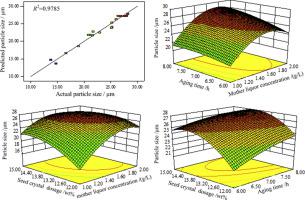当前位置:
X-MOL 学术
›
J. Rare Earths
›
论文详情
Our official English website, www.x-mol.net, welcomes your
feedback! (Note: you will need to create a separate account there.)
Optimization of rare earth carbonate reactive-crystallization process based on corresponding surface
Journal of Rare Earths ( IF 5.2 ) Pub Date : 2021-01-01 , DOI: 10.1016/j.jre.2020.03.011 Dongmei Zhu , Qianwen Chen , Tingsheng Qiu , Guanfei Zhao , Xihui Fang
Journal of Rare Earths ( IF 5.2 ) Pub Date : 2021-01-01 , DOI: 10.1016/j.jre.2020.03.011 Dongmei Zhu , Qianwen Chen , Tingsheng Qiu , Guanfei Zhao , Xihui Fang

|
Abstract Rare earth carbonate precipitation is mainly amorphous, of large volume and difficult to filter. To prepare crystalline rare earth carbonate, mother liquor of heavy rare earth was taken as research object, and the experimental scheme was designed based on the response surface central composite design (CCD) method. The concentration of mother liquor, aging time and seed crystal dosage were taken as independent variables, and the particle size of rare earth carbonate was taken as the response value to establish a quadratic polynomial numerical model to optimize the reactive-crystallization process of rare earth carbonate. The results show that these three factors have significant effect on the particle size of rare earth carbonate, and the influence order is mother liquid concentration > aging time > seed crystal dosage. Moreover, the interaction between mother liquor concentration and seed crystal dosage has a significant effect on the size of rare earth carbonate particles. The optimal parameters predicted by the model are as follows: the concentration of mother liquid is 1.75 g/L, seed crystal dosage is 13.56 wt%, and aging time is 8 h. Under these conditions, the predicted particle size is 28.74 μm, and the experiment particle size is 28.23 μm, between both, the relative error is 0.73%, which indicates that the established response surface model has a good prediction effect and a certain practical significance to guide the reactive-crystallization process of rare earth carbonate. The obtained rare earth carbonate has a crystallinity of 97.82%, uniform particles size, and low-hydrated crystals with a tengerite structure.
中文翻译:

基于相应表面的碳酸稀土反应结晶工艺优化
摘要 碳酸稀土沉淀以无定形为主,体积大,过滤困难。以重稀土母液为研究对象,制备结晶稀土碳酸盐,基于响应面中心复合设计(CCD)方法设计了实验方案。以母液浓度、陈化时间和晶种用量为自变量,以碳酸稀土粒径为响应值,建立二次多项式数值模型,优化碳酸稀土反应结晶过程. 结果表明,这三个因素对碳酸稀土的粒径都有显着影响,影响顺序为母液浓度>老化时间>晶种用量。而且,母液浓度和晶种用量之间的相互作用对碳酸稀土颗粒的尺寸有显着影响。模型预测的最佳参数为:母液浓度为1.75 g/L,晶种用量为13.56 wt%,老化时间为8 h。在这些条件下,预测粒径为28.74 μm,实验粒径为28.23 μm,两者的相对误差为0.73%,说明所建立的响应面模型具有较好的预测效果,具有一定的实际意义。指导稀土碳酸盐的反应结晶过程。得到的稀土碳酸盐结晶度为97.82%,粒径均匀,低水合晶体具有钨钛矿结构。
更新日期:2021-01-01
中文翻译:

基于相应表面的碳酸稀土反应结晶工艺优化
摘要 碳酸稀土沉淀以无定形为主,体积大,过滤困难。以重稀土母液为研究对象,制备结晶稀土碳酸盐,基于响应面中心复合设计(CCD)方法设计了实验方案。以母液浓度、陈化时间和晶种用量为自变量,以碳酸稀土粒径为响应值,建立二次多项式数值模型,优化碳酸稀土反应结晶过程. 结果表明,这三个因素对碳酸稀土的粒径都有显着影响,影响顺序为母液浓度>老化时间>晶种用量。而且,母液浓度和晶种用量之间的相互作用对碳酸稀土颗粒的尺寸有显着影响。模型预测的最佳参数为:母液浓度为1.75 g/L,晶种用量为13.56 wt%,老化时间为8 h。在这些条件下,预测粒径为28.74 μm,实验粒径为28.23 μm,两者的相对误差为0.73%,说明所建立的响应面模型具有较好的预测效果,具有一定的实际意义。指导稀土碳酸盐的反应结晶过程。得到的稀土碳酸盐结晶度为97.82%,粒径均匀,低水合晶体具有钨钛矿结构。











































 京公网安备 11010802027423号
京公网安备 11010802027423号